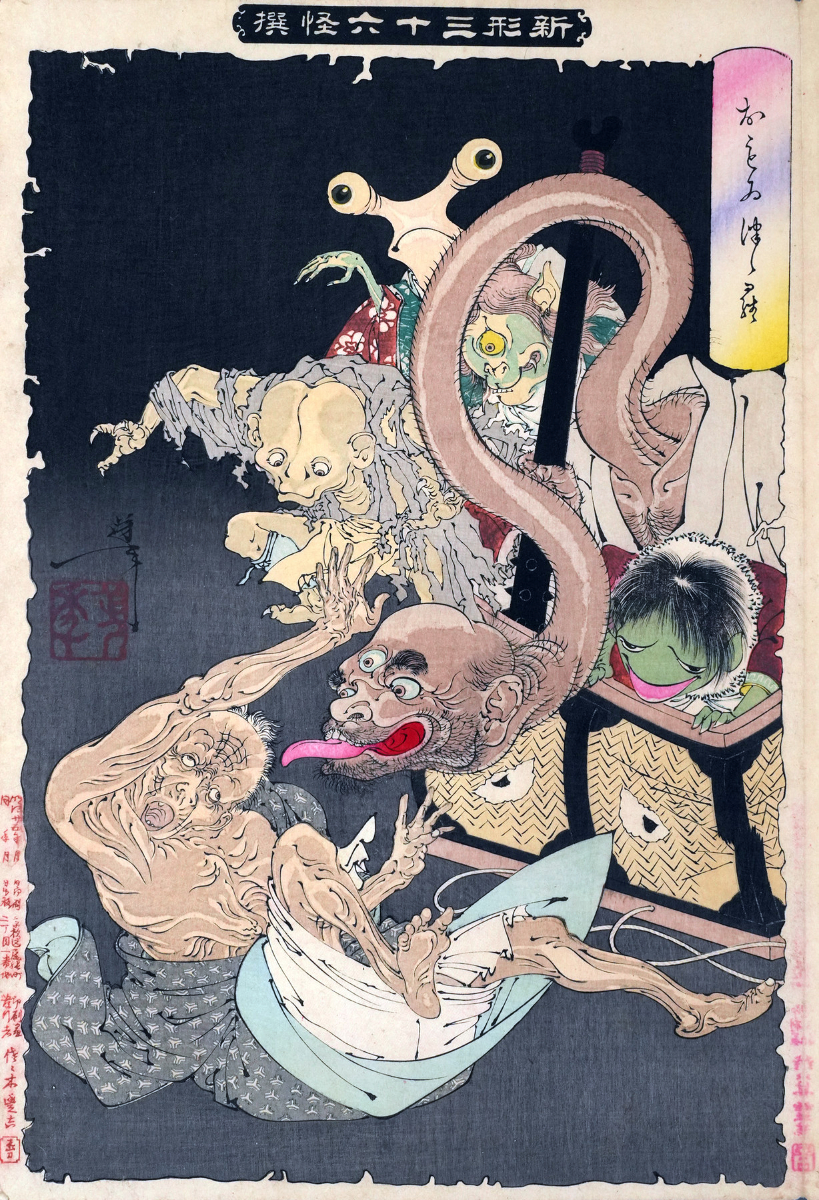Yōkai (“strange apparition”) are a class of supernatural entities and spirits in Japanese folklore. The word yōkai is composed of the kanji for “attractive; calamity” and “apparition; mystery; suspicious.” Yōkai are also referred to as ayakashi, mononoke, or mamono. Despite often being translated as such, yōkai are not literally demons in the Western sense of the word, but are instead spirits and entities. Their behavior can range from malevolent or mischievous to benevolent to humans. Yōkai often have animal features (such as the kappa, depicted as appearing similar to a turtle, and the tengu, commonly depicted with wings), but may also appear humanoid in appearance, such as the kuchisake-onna. Some yōkai resemble inanimate objects (such as the tsukumogami), while others have no discernible shape. Yōkai are typically described as having spiritual or supernatural abilities, with shapeshifting being the most common trait associated with them. Yōkai that shapeshift are known as bakemono or obake. Japanese folklorists and historians explain yōkai as personifications of “supernatural or unaccountable phenomena to their informants.” In the Edo period, many artists, such as Toriyama Sekien, invented new yōkai by taking inspiration from folk tales or purely from their own imagination. Today, several such yōkai (such as the amikiri) are mistakenly thought to originate in more traditional folklore.
| Alias Yōkai |
| Real Names/Alt Names Various |
| Characteristics Personification, Trickster, Myths & Legends, Ghost, Yōkai, Shapeshifter, Medieval Age, Japanese |
| Creators/Key Contributors Toriyama Sekien, Tsukioka Yoshitoshi |
| First Appearance Japanese folklore |
| First Publisher ○ |
| Appearance List Literature: Shoku Nihongi (72 CE), The Pillow Book by Sei Shōnagon (Heian period), Taiheiki (fifth volume, 1370), Kojiki, Nihon Shoki, various Fudoki, Konjaku Monogatarishū (Heian period), Otogi-zōshi (1392-1573), Shokoku Hyakumonogatari (1677), Otogi Hyakumonogatari (1706), Wakan Sansai Zue by Terajima Ryōan (1712), Sesetsu Kojien (1716), Bakemono chakutocho by Masayoshi Kitao (1788), Seiyuu Youkai Kidan by Shibue Tamotsu (1891), Yōkaigaku Kogi by Inoue Enryō (1896), Yami no Ume Hyakumonogatari (kabuki play, 1900), Shokubutsu Kaiko by Mitsutaro Shirai (1914). Podcast: Astonishing Legends: Episode 121 Yokai Horrors of Japan. |
| Sample Read Astonishing Legends: Episode 121 Yokai Horrors of Japan [YT] |
| Description Yōkai (“strange apparition”) are a class of supernatural entities and spirits in Japanese folklore. The word yōkai is composed of the kanji for “attractive; calamity” and “apparition; mystery; suspicious.” Yōkai are also referred to as ayakashi, mononoke, or mamono. Despite often being translated as such, yōkai are not literally demons in the Western sense of the word, but are instead spirits and entities. Their behavior can range from malevolent or mischievous to benevolent to humans. Yōkai often have animal features (such as the kappa, depicted as appearing similar to a turtle, and the tengu, commonly depicted with wings), but may also appear humanoid in appearance, such as the kuchisake-onna. Some yōkai resemble inanimate objects (such as the tsukumogami), while others have no discernible shape. Yōkai are typically described as having spiritual or supernatural abilities, with shapeshifting being the most common trait associated with them. Yōkai that shapeshift are known as bakemono or obake. Japanese folklorists and historians explain yōkai as personifications of “supernatural or unaccountable phenomena to their informants.” In the Edo period, many artists, such as Toriyama Sekien, invented new yōkai by taking inspiration from folk tales or purely from their own imagination. Today, several such yōkai (such as the amikiri) are mistakenly thought to originate in more traditional folklore. |
| Source Yokai – Wikipedia |

